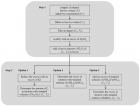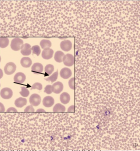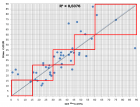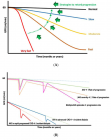Abstract
Review Article
Stoichiometric approach to redox back titrations in ethanol analyses
Anna M Michałowska-Kaczmarczyk and Tadeusz Michałowski*
Published: 11 June, 2019 | Volume 3 - Issue 1 | Pages: 001-006
This article refers to calculations involved with determination of ethanol, analyzed according to redox back titration principle. A quantitative reasoning, based on logical sequence of statements, is presented for derivation of the formulas required to calculate the results of chemical analyses according to stoichiometric principles. The titrations are considered as two-step analytical procedures. This way, one can gain an insight into a classical redox titration and get a knowledge on the advantages of back titrations.
Read Full Article HTML DOI: 10.29328/journal.aac.1001017 Cite this Article Read Full Article PDF
Keywords:
Ethanol analysis; Redox titration; Back titration; Stoichiometry
References
- Ferguson J. Estimation of Alcohol Content in Wine by Dichromate Oxidation followed by Redox Titration. Sirromet Wines Pty Ltd. Ref.: http://bit.ly/2WuM4PG
- Bhosale Y, Mulani K, Rathod V. A Rapid and Precise Titration Method for Analysis of Ethanol: Comparison among Serum-Whole Blood Alcohol Concentration. Open Acc Blood Res Trans J. 2017; 1: 001-003. Ref.: http://bit.ly/2R193AR
- Determination of Ethanol Concentration in Aqueous Solutions. College of Science. University of Canterbury. Ref.: http://bit.ly/2K8PAxI
- Redox Titration of Ethanol in Wine and Beer. Ref.: http://bit.ly/2K6qC1R
- AP Chemistry. Determination of the Alcohol Content of Root Beer Lab. Ref.: http://bit.ly/2R1bOCd
- Determination of Ethanol Concentration in Aqueous Solutions, College of Science, University of Canterbury. Ref.: http://bit.ly/2K8PAxI
- Jain NC, Cravey RH. Analysis of alcohol. I. A review of chemical and infrared methods. J Chromatogr Sci. 1972; 10: 257-262. Ref.: http://bit.ly/2WWsRLb
- Thompson T. Determining Blood/Alcohol Concentration: Two Methods of Analysis, Montana Law Review. 1985; 46: 365-379. Ref.: http://bit.ly/2KbzfIu
- Ruz J, Fernandez A, De Castro MDL, Valcarcel M. Determination of ethanol in human fluids — I. Determination of ethanol in blood. J Pharmace Bio Analysis. 1986; 4: 545-558. : http://bit.ly/31j8APb
- Wang ML, Su NW, Choong YM, Lee MH. A rapid method for determination of ethanol in alcoholic beverages using capillary gas chromatography. Journal of Food and Drug Analysis. 2003; 11: 133-140. Ref.: http://bit.ly/2WvQIlw
- Miah R, Siddiqa A, Tuli JF, Barman NK, Dey SK, et al. Inexpensive Procedure for Measurement of Ethanol: Application to Bioethanol Production Process. Advances in Microbiology. 2007; 7: 743-748. Ref.: http://bit.ly/2ZjtSKD
- Archer M, de Vos J, Visser MS. The preparation, assay and certification of aqueous ethanol reference solutions. Accreditation and Quality Assurance. 2007; 12: 188-193. : http://bit.ly/2IySet7
- Michałowska-Kaczmarczyk AM, Spórna-Kucab A, Michałowski T. Generalized Electron Balance (GEB) as the Law of Nature in Electrolytic Redox Systems3 in: Redox: Principles and Advanced Applications. Ali Khalid MA (Ed.) InTech. 2017; Chap 2: 9-55. Ref.: http://bit.ly/2MCnX28
- Michałowska-Kaczmarczyk AM, Spórna-Kucab A, Michałowski T0 Principles of Titrimetric Analyses According to Generalized Approach to Electrolytic Systems (GATES), in: Advances in Titration Techniques, Vu Dang Hoang (Ed.) InTech. 2017; Chap. 5: 133-171. Ref.: http://bit.ly/2X045d4
- Michałowska-Kaczmarczyk AM, Spórna-Kucab A, Michałowski T. A Distinguishing Feature of the Balance 2∙f(O) – f(H) in Electrolytic Systems. The Reference to Titrimetric Methods of Analysis, in: Advances in Titration Techniques. Vu Dang Hoang (Ed.) InTech. 2017; Chap 6: 173-207. Ref.: http://bit.ly/2K8R8b0
- Michałowska-Kaczmarczyk AM, Spórna-Kucab A, Michałowski T. Solubility products and solubility concepts, in: Descriptive Inorganic Chemistry. Researches of Metal Compounds. Akitsu T. (Ed.) InTech. 2017; Chap 5: 93-134. Ref.: http://bit.ly/2Wo6c6c
- Wilkinson L. Optimum conditions of the acid dichromate method for determining ethanol in body fluids. Analyst. 1985;83: 390-401. Ref.: https://rsc.li/2FcXouj
- OIV – Organisation Internationale de la Vigne et du Vin. Compendium of Methods of Analysis of Wine Vinegars. Resolution OENO 56-2000 V Wine Vinegards – Determination of the residual alcohol content. Ref.: http://bit.ly/2F2yAov
- Association of Official Analytical Chemists (AOAC). Official Methods of Analysis. 16th ed.; AOAC: Gaithersburg, MD. 1997; 28.1-28.3.
- Sáez Plaza P, Martín J, Asuero AG. Dichromate oxidation of ethanol and phenol bromination: a tale of two reactions, Anales de la Real Academia Nacional de Farmacia. 2017; 83: 313-320. Ref.: http://bit.ly/2Xxy4WO
Figures:

Figure 1
Similar Articles
-
Stoichiometric approach to redox back titrations in ethanol analysesAnna M Michałowska-Kaczmarczyk,Tadeusz Michałowski*. Stoichiometric approach to redox back titrations in ethanol analyses. . 2019 doi: 10.29328/journal.aac.1001017; 3: 001-006
Recently Viewed
-
Post-COVID Pulmonary Fibrosis: Pathophysiological Mechanisms, Diagnostic Tools, and Emerging TherapiesSowparnika Treasa Sabu*. Post-COVID Pulmonary Fibrosis: Pathophysiological Mechanisms, Diagnostic Tools, and Emerging Therapies. J Pulmonol Respir Res. 2025: doi: 10.29328/journal.jprr.1001067; 9: 009-013
-
Sinonasal Myxoma Extending into the Orbit in a 4-Year Old: A Case PresentationJulian A Purrinos*, Ramzi Younis. Sinonasal Myxoma Extending into the Orbit in a 4-Year Old: A Case Presentation. Arch Case Rep. 2024: doi: 10.29328/journal.acr.1001099; 8: 075-077
-
Sotatercept in the Treatment of Pulmonary Arterial Hypertension: A Comprehensive Narrative Review of Mechanism, Efficacy and Future DirectionsNiroshan Ranjan*,Ahmed Ahmed,Jordana Woods,Ramaneshwar Selvaraj,Mihir Patel,Yaman Dalati,Vidushan Sabanathan,Thanujan Thangadurai. Sotatercept in the Treatment of Pulmonary Arterial Hypertension: A Comprehensive Narrative Review of Mechanism, Efficacy and Future Directions. J Pulmonol Respir Res. 2025: doi: 10.29328/journal.jprr.1001068; 9: 014-022
-
Investigation of Bronchoscopy Associated Pseudo-infectionsKrishnaveni Malisetti*. Investigation of Bronchoscopy Associated Pseudo-infections. J Pulmonol Respir Res. 2025: doi: 10.29328/journal.jprr.1001066; 9: 006-008
-
Anesthesia Considerations in Scoliosis Surgery - A Clinical CommunicationAnagha Warik,Abinav Sarvesh*. Anesthesia Considerations in Scoliosis Surgery - A Clinical Communication. Int J Clin Anesth Res. 2025: doi: 10.29328/journal.ijcar.1001030; 9: 023-025
Most Viewed
-
Evaluation of Biostimulants Based on Recovered Protein Hydrolysates from Animal By-products as Plant Growth EnhancersH Pérez-Aguilar*, M Lacruz-Asaro, F Arán-Ais. Evaluation of Biostimulants Based on Recovered Protein Hydrolysates from Animal By-products as Plant Growth Enhancers. J Plant Sci Phytopathol. 2023 doi: 10.29328/journal.jpsp.1001104; 7: 042-047
-
Sinonasal Myxoma Extending into the Orbit in a 4-Year Old: A Case PresentationJulian A Purrinos*, Ramzi Younis. Sinonasal Myxoma Extending into the Orbit in a 4-Year Old: A Case Presentation. Arch Case Rep. 2024 doi: 10.29328/journal.acr.1001099; 8: 075-077
-
Feasibility study of magnetic sensing for detecting single-neuron action potentialsDenis Tonini,Kai Wu,Renata Saha,Jian-Ping Wang*. Feasibility study of magnetic sensing for detecting single-neuron action potentials. Ann Biomed Sci Eng. 2022 doi: 10.29328/journal.abse.1001018; 6: 019-029
-
Physical activity can change the physiological and psychological circumstances during COVID-19 pandemic: A narrative reviewKhashayar Maroufi*. Physical activity can change the physiological and psychological circumstances during COVID-19 pandemic: A narrative review. J Sports Med Ther. 2021 doi: 10.29328/journal.jsmt.1001051; 6: 001-007
-
Pediatric Dysgerminoma: Unveiling a Rare Ovarian TumorFaten Limaiem*, Khalil Saffar, Ahmed Halouani. Pediatric Dysgerminoma: Unveiling a Rare Ovarian Tumor. Arch Case Rep. 2024 doi: 10.29328/journal.acr.1001087; 8: 010-013

HSPI: We're glad you're here. Please click "create a new Query" if you are a new visitor to our website and need further information from us.
If you are already a member of our network and need to keep track of any developments regarding a question you have already submitted, click "take me to my Query."

















































































































































